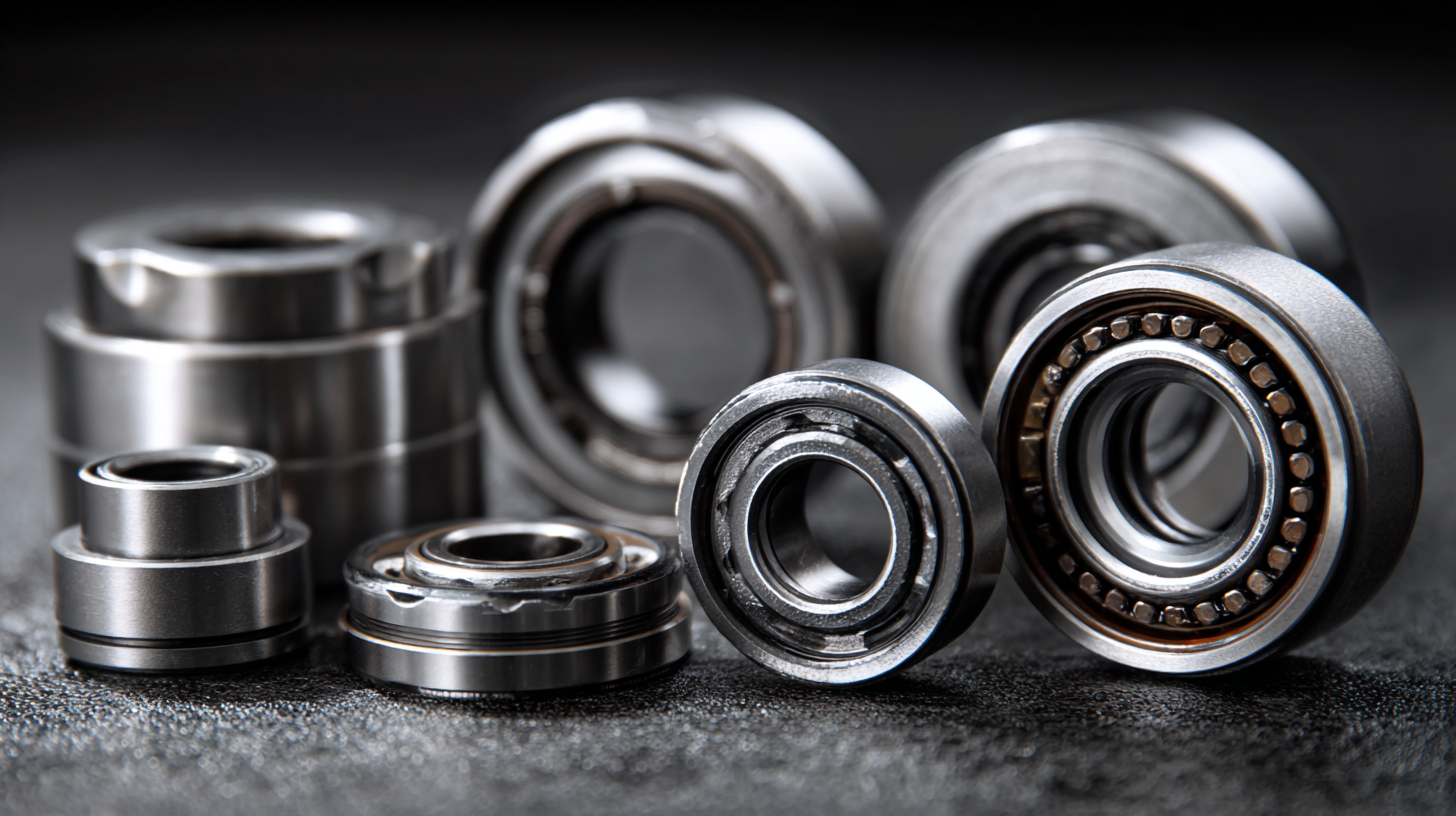Exploring Bearing Size Cross Reference Charts for Better Product Comparisons
In the ever-evolving world of mechanical engineering, selecting the right bearing is paramount for ensuring optimal performance and longevity of machinery. The use of a Bearing Size Cross-Reference Chart has become an essential tool for engineers and technicians alike.
According to a report by the International Bearing Association, nearly 30% of equipment failures can be attributed to improper bearing selections, highlighting the critical nature of precise comparisons.
These charts not only streamline the selection process but also enhance compatibility across various brands and models, ultimately saving time and reducing costs.
With the global bearings market projected to reach $85 billion by 2025, understanding how to effectively utilize these cross-reference charts is crucial for optimizing product comparisons and maintaining competitive advantage in a crowded marketplace.
Understanding the Importance of Bearing Size Cross Reference Charts
Bearing size cross reference charts play an essential role in the engineering and manufacturing industries, providing crucial data that aids in the selection and comparison of bearings. These charts allow engineers to easily identify equivalent bearings from different manufacturers, ensuring compatibility and performance in various applications. According to a report by MarketsandMarkets, the global bearing market is expected to reach $90.9 billion by 2024, and the demand for accurate cross referencing has increased significantly alongside this growth. The ability to efficiently compare bearing sizes can lead to cost savings and improved product reliability.
Furthermore, the significance of these cross reference charts is not merely in providing dimensions; they also factor in critical attributes such as load capacity, operating temperature ranges, and material compositions. For instance, the International Organization for Standardization (ISO) outlines various standards that bearing manufacturers must meet, highlighting the importance of uniformity and reliability across brands. As per a study published in the Journal of Mechanical Engineering, improper bearing selection can lead to substantial operational failures, underscoring the need for precise cross referencing to enhance product performance and longevity. By leveraging these charts, engineers can make informed decisions that ultimately result in optimized machinery and reduced maintenance costs.
Key Factors to Consider When Exploring Bearing Alternatives
When exploring bearing alternatives, several key factors must be considered to ensure optimal performance and compatibility. First and foremost is the load capacity of the bearings. Different applications require bearings that can handle varying levels of weight and stress. It's essential to cross-reference load ratings in 'Bearing Size Cross Reference Charts' to find suitable alternatives that can withstand operational demands without compromising reliability.
Another critical factor is the bearing material. The choice of material affects not only the strength and durability of the bearing but also its resistance to corrosion and wear. For instance, stainless steel bearings are ideal for environments exposed to moisture, while polymer bearings may be preferred for applications requiring lightweight and high resistance to chemical exposure. Understanding these material properties can guide users in selecting bearings that enhance equipment longevity.
Lastly, compatibility with existing systems cannot be ignored. Dimensions, mounting configurations, and operational speeds must all align with the requirements of the machinery in which the bearings will be used. Using cross-reference charts allows for a thorough comparison of various bearing specifications, enabling decisions that prioritize seamless integration and performance efficiency.
Exploring Bearing Size Cross Reference Charts for Better Product Comparisons
| Bearing Type |
Inner Diameter (mm) |
Outer Diameter (mm) |
Width (mm) |
Load Rating (Cr) (N) |
Dynamic Load Rating (C) (N) |
Static Load Rating (Co) (N) |
| Deep Groove Ball Bearing |
20 |
42 |
12 |
8800 |
10400 |
4800 |
| Tapered Roller Bearing |
30 |
62 |
16 |
9450 |
11300 |
5500 |
| Cylindrical Roller Bearing |
25 |
52 |
15 |
7600 |
9300 |
3800 |
| Self-Aligning Ball Bearing |
22 |
50 |
14 |
8500 |
10200 |
4900 |
| Angular Contact Bearing |
18 |
42 |
12 |
7700 |
9500 |
4600 |
How to Effectively Compare Bearing Products Using Size Charts
When it comes to selecting the right bearings for your mechanical applications, understanding size cross-reference charts is essential for making informed product comparisons. These charts serve as a valuable tool, allowing engineers and technicians to evaluate different bearing options based on key dimensions such as inner and outer diameters, width, and load ratings. By efficiently comparing these specifications, one can avoid incompatibility issues and ensure optimal performance of machinery.
To effectively utilize size charts in your bearing comparisons, start by gathering all pertinent details of the bearings you're considering. Pay attention to the tolerance levels and quality standards specified by manufacturers, as these factors can significantly impact performance and durability. Cross-reference the measurements against those of alternative products to identify suitable replacements or upgrades. This systematic approach not only aids in a straightforward comparison but also enhances overall procurement efficiency, helping you find the perfect bearings tailored to your unique mechanical needs.
Comparative Analysis of Bearing Sizes
This chart illustrates the comparative sizes of various types of bearings based on their inner and outer diameters. The data reflects a common range of bearing sizes for better understanding in product selection.
Common Mistakes When Interpreting Bearing Size Cross Reference Data
When interpreting bearing size cross reference data, many professionals encounter common pitfalls that can lead to costly errors. One significant mistake is assuming that dimensions alone will ensure compatibility across different manufacturers. While size is a crucial factor, other specifications such as tolerances, materials, and internal design features can dramatically affect performance. According to a study by the National Association of Manufacturers, about 30% of bearing failures stem from improper selection, often due to oversight in these areas.
Another critical error arises from overlooking the differences in naming conventions and standards between manufacturers. For instance, a common bearing might have multiple designations in the marketplace. A report from the American Society of Mechanical Engineers highlights that confusion in part numbers can result in mismatched components, ultimately leading to increased maintenance costs and downtime. Therefore, it is essential to consult comprehensive cross reference charts that not only list sizes but also provide detailed specifications and contextual information to make informed choices when selecting bearings.

Tips for Selecting the Best Bearing Alternatives for Your Needs
When selecting bearing alternatives, it is essential to consider various factors that can impact performance and longevity. According to a report by the International Journal of Engineering Research and Applications (IJERA), bearing failure accounts for nearly 40% of unplanned downtime in industrial machinery. Therefore, understanding the specifications and cross-reference charts of different bearing sizes is crucial. These charts allow engineers to compare various manufacturers' products based on load ratings, speed limits, and environmental considerations, ensuring that they make well-informed decisions tailored to their specific applications.
Additionally, the data from the Bearing Manufacturers Association (BMA) indicates that selecting the correct bearing can potentially enhance efficiency by up to 30%. This highlights the need to thoroughly evaluate alternatives not just in terms of compatibility, but also for operational parameters like lubrication type and load capacity. For instance, when comparing a deep groove ball bearing with a tapered roller bearing, the choice may hinge on the application requirements, such as axial load handling and radial load distribution. Utilizing cross-reference charts effectively equips users with the insights needed to select optimal alternatives that can significantly reduce operational costs and enhance machine reliability.


Home
Products
Industrial Bearings
Deep Groove Ball Bearings
Self-Aligning Ball Bearings
Angular Contact Ball Bearings
Cylindrical Roller Bearings
Taper Roller Bearings
Spherical Roller Bearings
Bearing housing or Accessories
Miniature Bearing
Thrust ball bearing
Radial Spherical Plain Bearing
Pillow Block Bearing
Needle Roller Bearings
Automotive Bearings
Agricultural Bearings
Special Material Bearings
Industry Application
About Us
News
Contact Us





